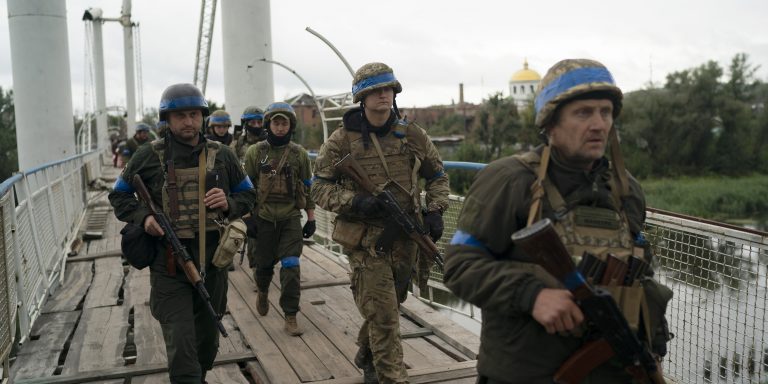INTELBRIEF
September 15, 2022
IntelBrief: Ukrainian Counteroffensive Continues to Keep Russian Forces Off Balance

Bottom Line Up Front
- Ukraine’s counteroffensive has impressed military analysts, as Russian military units have been forced to retreat and pressure grows on the Kremlin and President Vladimir Putin’s inner circle.
- Ukrainian forces have retaken most of the Kharkiv region, with Russian troops retreating hastily and leaving behind tanks, armored vehicles, and other equipment.
- Western weaponry and ammunition have been critical to the counteroffensive, but it has been the Ukrainians’ will to fight and resilience that has been the difference maker so far.
- The loss of Kharkiv is among the most significant setbacks suffered by the Russians since Moscow began its ill-fated invasion in late February.
Ukraine’s counteroffensive has impressed military analysts and observers, as Russian military units have been forced to retreat and pressure grows on the Kremlin and President Vladimir Putin’s inner circle. Some have even called the counteroffensive, which has reclaimed more than 6,000 square kilometers in just over a week according to Ukrainian officials, a turning point in the conflict. Ukrainian forces have allegedly seized Kupyansk, Izyyum, and Balakliya and, in the process, have also taken over warehouses where Russian forces were storing arms and ammunition. But there is a risk of extrapolating too much, and prospects for negotiations remain highly unlikely. Putin grossly miscalculated and the conflict is now becoming an embarrassment for Russians, including Gen. Valery Gerasimov and Defense Minister Sergei Shoigu.
Following a lightning-quick terrain-oriented attack, Ukrainian forces have retaken most of the Kharkiv region, with Russian troops retreating hastily and leaving behind tanks, armored vehicles, and other equipment. Russia is still occupying Mariupol and Kherson; however, in addition to gains in Kharkiv, Ukrainian forces are also making progress in parts of Donetsk and Luhansk. Ukrainian advances toward Kherson in the south were not a feint, as had been widely reported, but merely a second line of effort and one that could succeed in pushing Russian troops back from the western bank of the Dnieper River. Recent fighting has demonstrated the depth of Russia’s faltering sustainment and logistical failures. Former Russian Duma deputy Boris Nadezhdin, while appearing on a Russian television show recently, declared, “People who convinced President Putin that our special operation would be effective and brief, that we wouldn’t strike the civilian population, that we’d come and restore order, these people basically set us up.” There is also growing dissent among longtime Putin loyalists, including among hardline ultra-nationalists who are angry at the Kremlin for, from their perspective, not unleashing the full might of the Russian military in Ukraine.
Western weaponry and ammunition have been essential to the counteroffensive, but it has been the Ukrainians’ will to fight and other difficult-to-measure intangibles, like their resilience, that has been the difference maker so far. Broadly, Ukrainian forces have been praised for operations security (OPSEC) and battlefield discipline. Russia responded to recent setbacks with a renewed bombing campaign, targeting Ukrainian critical infrastructure, including electric and water utilities. In contrast to Putin’s paranoid leadership, Ukrainian President Volodymyr Zelensky projects calm confidence, reassuring Ukrainian citizens and warning the Kremlin that Ukraine will not cede any territory currently occupied by Russia. There are growing concerns that as the Ukrainians rout Russian military forces in cities, towns, and villages, it could increase Moscow’s willingness to use tactical nuclear weapons. Prominent Russian voices are attempting to frame the conflict as a contest between Russia and NATO, waging an aggressive disinformation campaign to distort the facts and place blame elsewhere.
Ukrainian forces will be looking to capitalize upon this momentum, focusing on consolidating hard-fought gains. In the meantime, Kyiv will be looking for more weapons from the West, including Army Tactical Missile Systems (ATACMS) with a range of approximately 190 miles. HIMARS, long-range rockets, have provided a significant boost to Ukrainian forces as they set the stage to retake occupied territory. To date, the U.S. has refrained from providing more sophisticated weaponry to Ukraine, fearing that they could further antagonize Putin if Ukrainian forces use U.S. and Western-supplied weaponry to launch attacks directly on Russian soil. Still, the valiant and courageous performance by Ukrainian forces will make it difficult for those in Washington, London, and Brussels to withhold more advanced weaponry, in the face of demands and Ukrainian battlefield effectiveness. The loss of Kharkiv is among the most significant setbacks suffered by the Russians since Moscow began its ill-fated invasion in late February. Moreover, the loss raises the question of whether Putin will seek to implement a military draft to bolster military manpower in what is increasingly becoming an unpopular war amongst Russian citizens. Moscow’s growing reliance on private military contractors from the Wagner Group demonstrates a sense of desperation, a reality exacerbated by this week’s battlefield developments.